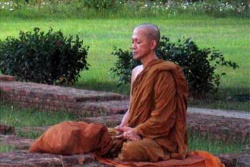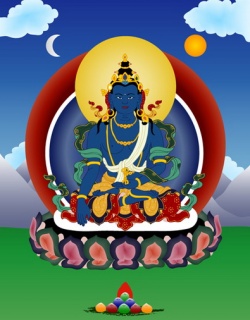Difference between revisions of "Rule of Kanishka (78 – 120 A.D.)"
(Created page with "Kanishka was the most important ruler of the Kushana dynasty. He was the founder of the Saka era which starts from 78 A.D. He was not only a great conqueror bu...") |
|||
| Line 1: | Line 1: | ||
| + | {{DisplayImages|559|1925}} | ||
[[Kanishka]] was the most important [[ruler]] of the [[Kushana dynasty]]. He was the founder of the [[Saka era]] which starts from 78 A.D. He was not only a great conqueror but also a {{Wiki|patron}} of [[religion]] and [[art]]. | [[Kanishka]] was the most important [[ruler]] of the [[Kushana dynasty]]. He was the founder of the [[Saka era]] which starts from 78 A.D. He was not only a great conqueror but also a {{Wiki|patron}} of [[religion]] and [[art]]. | ||
[[Kanishka’s]] Conquests | [[Kanishka’s]] Conquests | ||
| − | At the [[time]] of his accession his [[empire]] included [[Afghanistan]], [[Gandhara]], Sind and [[Punjab]]. Subsequently he conquered [[Magadha]] and extended his power as far as [[Pataliputra]] and [[Bodh Gaya]]. According to Kalhana, [[Kanishka]] invaded [[Kashmir]] and occupied it. His coins are found in many places like [[Mathura]], [[Sravasti]], Kausambi and [[Benares]] and therefore, he must have conquered the greater part of the Gangetic plain. He also fought against the {{Wiki|Chinese}} and acquired some territories from them. During the first expedition he was defeated by the {{Wiki|Chinese}} general Pancho. He undertook a second expedition in which he was successful and he scored a victory over Panyang, the son of Pancho. [[Kanishka]] annexed the territories of [[wikipedia:Kashgar|Kashgar]], {{Wiki|Yarkand}} and [[wikipedia:Khotan|Khotan]] into his [[empire]]. The [[empire]] of [[Kanishka]] was a vast one extending from | + | At the [[time]] of his accession his [[empire]] included [[Afghanistan]], [[Gandhara]], Sind and [[Punjab]]. Subsequently he conquered [[Magadha]] and extended his power as far as [[Pataliputra]] and [[Bodh Gaya]]. According to [[Kalhana]], [[Kanishka]] invaded [[Kashmir]] and occupied it. His coins are found in many places like [[Mathura]], [[Sravasti]], [[Kausambi]] and [[Benares]] and therefore, he must have conquered the greater part of the Gangetic plain. He also fought against the {{Wiki|Chinese}} and acquired some territories from them. During the first expedition he was defeated by the {{Wiki|Chinese}} general [[Pancho]]. He undertook a second expedition in which he was successful and he scored a victory over [[Panyang]], the son of [[Pancho]]. [[Kanishka]] annexed the territories of [[wikipedia:Kashgar|Kashgar]], {{Wiki|Yarkand}} and [[wikipedia:Khotan|Khotan]] into his [[empire]]. The [[empire]] of [[Kanishka]] was a vast one extending from [[Gandhara]] in the [[west]] to [[Benares]] in the [[east]], and from [[Kashmir]] in the [[north]] to {{Wiki|Malwa}} in the [[south]]. His capital was Purushapura or {{Wiki|modern}} day {{Wiki|Peshawar}}. [[Mathura]] was another important city in his [[empire]]. |
| − | [[Gandhara]] in the [[west]] to [[Benares]] in the [[east]], and from [[Kashmir]] in the [[north]] to {{Wiki|Malwa}} in the [[south]]. His capital was Purushapura or {{Wiki|modern}} day {{Wiki|Peshawar}}. [[Mathura]] was another important city in his [[empire]]. | ||
[[Kanishka]] and [[Buddhism]] | [[Kanishka]] and [[Buddhism]] | ||
| − | [[Kanishka]] embraced [[Buddhism]] in the early part of his reign. However, his coins exhibit the images of not only [[Buddha]] but also {{Wiki|Greek}} and [[Hindu]] [[gods]]. It reflects the Kanishka’s toleration towards other [[religions]]. In the age of [[Kanishka]] the [[Mahayana Buddhism]] came into vogue. It is different in many respects from the [[religion]] taught by the [[Buddha]] and propagated by [[Asoka]]. The [[Buddha]] came to be worshipped with [[flowers]], garments, [[perfumes]] and lamps. Thus image {{Wiki|worship}} and [[rituals]] developed in [[Mahayana Buddhism]]. | + | [[Kanishka]] embraced [[Buddhism]] in the early part of his reign. However, his coins exhibit the images of not only [[Buddha]] but also {{Wiki|Greek}} and [[Hindu]] [[gods]]. It reflects the [[Kanishka’s]] toleration towards other [[religions]]. In the age of [[Kanishka]] the [[Mahayana Buddhism]] came into vogue. It is different in many respects from the [[religion]] taught by the [[Buddha]] and propagated by [[Asoka]]. The [[Buddha]] came to be worshipped with [[flowers]], garments, [[perfumes]] and lamps. Thus image {{Wiki|worship}} and [[rituals]] developed in [[Mahayana Buddhism]]. |
| − | [[Kanishka]] also sent [[missionaries]] to {{Wiki|Central Asia}} and [[China]] for the [[propagation]] of the new [[faith]]. [[Buddhist]] [[chaityas]] and [[viharas]] were built in different places. He patronised [[Buddhist]] [[scholars]] like [[Vasumitra]], [[Asvagosha]] and [[Nagarjuna]]. He also convened the [[Fourth Buddhist Council]] to discuss matters relating to [[Buddhist]] {{Wiki|theology}} and [[doctrine]]. It was held at the Kundalavana [[monastery]] near [[Srinagar]] in [[Kashmir]] under the presidentship of [[Vasumitra]]. About 500 [[monks]] attended the Council. The Council prepared an authoritative commentary on the [[Tripitakas]] and the [[Mahayana]] [[doctrine]] was given final shape. [[Asvagosha]] was a great [[philosopher]], poet and dramatist. He was the author of [[Buddhacharita]]. [[Nagarjuna]] from [[south]] [[India]] adorned the court of [[Kanishka]]. The famous [[physician]] of {{Wiki|ancient India}} [[Charaka]] was also patronized by him. | + | [[Kanishka]] also sent [[missionaries]] to {{Wiki|Central Asia}} and [[China]] for the [[propagation]] of the new [[faith]]. [[Buddhist]] [[chaityas]] and [[viharas]] were built in different places. He patronised [[Buddhist]] [[scholars]] like [[Vasumitra]], [[Asvagosha]] and [[Nagarjuna]]. He also convened the [[Fourth Buddhist Council]] to discuss matters relating to [[Buddhist]] {{Wiki|theology}} and [[doctrine]]. It was held at the [[Kundalavana]] [[monastery]] near [[Srinagar]] in [[Kashmir]] under the presidentship of [[Vasumitra]]. About 500 [[monks]] attended the Council. The Council prepared an authoritative commentary on the [[Tripitakas]] and the [[Mahayana]] [[doctrine]] was given final shape. [[Asvagosha]] was a great [[philosopher]], poet and dramatist. He was the author of [[Buddhacharita]]. [[Nagarjuna]] from [[south]] [[India]] adorned the court of [[Kanishka]]. The famous [[physician]] of {{Wiki|ancient India}} [[Charaka]] was also patronized by him. |
| − | Successors of [[Kanishka]] and end of Kushana Rule | + | Successors of [[Kanishka]] and end of [[Kushana]] Rule |
The successors of [[Kanishka]] ruled for another one hundred and fifty years. [[Huvishka]] was the son of [[Kanishka]] and he kept the [[empire]] intact. [[Mathura]] became an important city under his rule. | The successors of [[Kanishka]] ruled for another one hundred and fifty years. [[Huvishka]] was the son of [[Kanishka]] and he kept the [[empire]] intact. [[Mathura]] became an important city under his rule. | ||
| + | {{R}} | ||
| + | [http://edu.holisticthought.com/rule-of-kanishka-78-120-a-d/ edu.holisticthought.com] | ||
| + | [[Category:History of Buddhism]] | ||
Latest revision as of 02:46, 25 April 2014
Kanishka was the most important ruler of the Kushana dynasty. He was the founder of the Saka era which starts from 78 A.D. He was not only a great conqueror but also a patron of religion and art.
Kanishka’s Conquests
At the time of his accession his empire included Afghanistan, Gandhara, Sind and Punjab. Subsequently he conquered Magadha and extended his power as far as Pataliputra and Bodh Gaya. According to Kalhana, Kanishka invaded Kashmir and occupied it. His coins are found in many places like Mathura, Sravasti, Kausambi and Benares and therefore, he must have conquered the greater part of the Gangetic plain. He also fought against the Chinese and acquired some territories from them. During the first expedition he was defeated by the Chinese general Pancho. He undertook a second expedition in which he was successful and he scored a victory over Panyang, the son of Pancho. Kanishka annexed the territories of Kashgar, Yarkand and Khotan into his empire. The empire of Kanishka was a vast one extending from Gandhara in the west to Benares in the east, and from Kashmir in the north to Malwa in the south. His capital was Purushapura or modern day Peshawar. Mathura was another important city in his empire. Kanishka and Buddhism
Kanishka embraced Buddhism in the early part of his reign. However, his coins exhibit the images of not only Buddha but also Greek and Hindu gods. It reflects the Kanishka’s toleration towards other religions. In the age of Kanishka the Mahayana Buddhism came into vogue. It is different in many respects from the religion taught by the Buddha and propagated by Asoka. The Buddha came to be worshipped with flowers, garments, perfumes and lamps. Thus image worship and rituals developed in Mahayana Buddhism. Kanishka also sent missionaries to Central Asia and China for the propagation of the new faith. Buddhist chaityas and viharas were built in different places. He patronised Buddhist scholars like Vasumitra, Asvagosha and Nagarjuna. He also convened the Fourth Buddhist Council to discuss matters relating to Buddhist theology and doctrine. It was held at the Kundalavana monastery near Srinagar in Kashmir under the presidentship of Vasumitra. About 500 monks attended the Council. The Council prepared an authoritative commentary on the Tripitakas and the Mahayana doctrine was given final shape. Asvagosha was a great philosopher, poet and dramatist. He was the author of Buddhacharita. Nagarjuna from south India adorned the court of Kanishka. The famous physician of ancient India Charaka was also patronized by him. Successors of Kanishka and end of Kushana Rule
The successors of Kanishka ruled for another one hundred and fifty years. Huvishka was the son of Kanishka and he kept the empire intact. Mathura became an important city under his rule.

